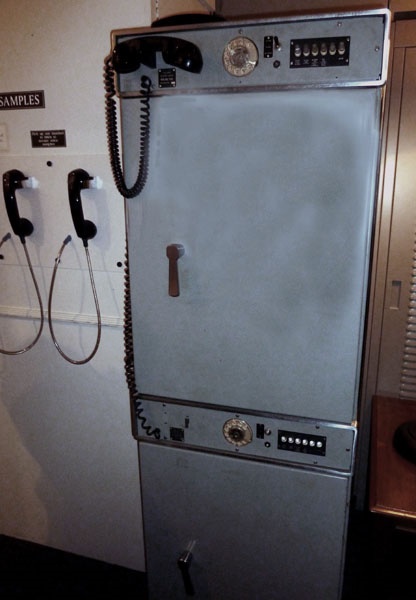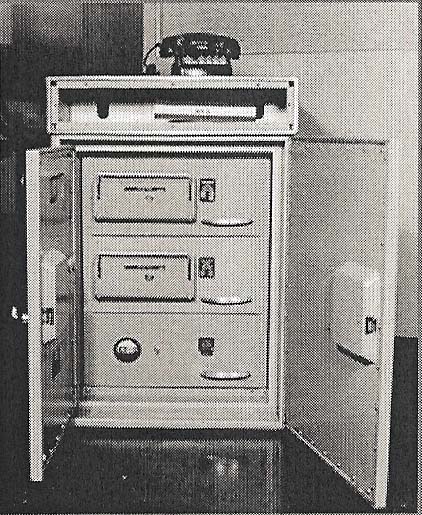Legend has it that the device was developed in the early 1960's after people had trouble understanding President Kennedy on previous voice encryption gear. The KY-3 used Pulse Code Modulation to digitize the full duplex voice circuit. The circuit boards contained potted modules rather then discrete components.
KY-3's were sometimes placed in the homes of higher ranking state
department officials. At 300 pounds, painted gray and resembling a safe,
it would usually be hidden in a locked closet, behind some sort of screen,
behind a large piece of furniture such as a couch, or in another room altogether
(basement). Where they had to remain in view, particularly in residences,
they were often painted in colors other than the standard gray, or covered
with some type of wallpaper.
 |
| This KY-3 example is held in the collection of the National Cryptologic Museum. (Photo by Ralph Simpson) |
 |
| A closer view of the front panel. The telephone assembly at the top of the cabinet is known as the KYX-10. This is a multiline phone whose pushbuttons are located at the right side of the mounting panel. (Photo courtesy Crypto Museum.com) |
The user was interconnected to the KY-3 via one of the remote desk sets. The KYX-10 was a larger multi-line unit, and was available in colors other than black. When properly adjusted, KY-3's had outstanding speech quality, rivaling that of a clean (unsecured) telephone line. The operative phrase here is "properly adjusted".
Bendix originally designed it to be half-duplex. After it was in production, the Government decided that it should be full-duplex. Bendix "modified" the existing design to accomplish this. They stuck boards in any and every slot available. This required the tech to jump from drawer to drawer (there were three drawers) when chasing signals around. It was already a complex machine to begin with.
The KY-3 used two card readers. One card encrypted transmissions while the other was used for decryption. These were Remington Rand computer punch cards that determined the starting point of the ncryption. Remington Rand computer punch cards used round, punched holes versus the rectangular holes found on IBM punch cards.
There are those who'll claim that the speech quality was poor, with a lot of distortion, hissing, or "popcorn" sounds, but that was only true with units that were in desperate need of adjustment. One maintainer said it was a "licensed bitch" to troubleshoot but anyone very familiar with the KY-3 could perform a complete adjustment within 15 minutes.
Other reports say that "the KY-3 was a very nice piece of gear. The average customer loved its voice quality since it was one of those rare encryption devices that you could tell who you were talking to just by their voice".
When new, the KY-3 cost around $US 10,500 per copy. Maintenance technicians had to spent about 5 months training on this device in crypto school.
The KY-3 was taken out of service when the last SECORD/AUTOSEVOCOM
Secure voice switch in the world was deactivated at the Pentagon in 1994.
